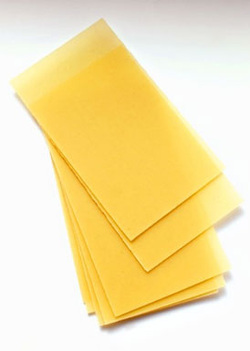|
Lasagna bianca, white lasagna seems to be a recent development in the Italian American Kitchen. To Italian Americans whose families date from the end of the 19th century and even the beginning of the 20th century what we today call “white lasagna” was completely unknown. Even during my younger years studying and travelling in Italy I do not recall seeing any kind of white lasagna. When I did a Google Italy search I found numerous recipes, but I could not find any sites that proposed the history of white lasagna. I really do not recall when I heard about white lasagna or vegetable lasagna. My best recollection dates white lasagna no more than twenty years ago. On the other hand, the history of the traditional Italian American red tomato sauce lasagna is rather extensive. I've posted a good bit of the history I have found on "Lasagna" at The Food Table.
The version of white lasagna that I set out here was prompted by a gift of garden grown Swiss chard from my kind friend and colleague Emma. Since we had a rather warm winter, her crop of Swiss chard did not die. So, here in early April she found herself knee deep in fully grown leaves that needed to be cut back. She brought me a bag full. When thinking of what to do with them I wanted to go beyond the usual sauté or soup recipes. Easter was just past, and spinach and ricotta pies were on my mind. The other influence was the traditional lasagna recipe that I had recently researched and completed on this site. With all these influence in mind it struck me, why not make Swiss chard lasagna? But would Swiss chard be substantial enough? |
Google Italy
I researched recipe after recipe on Google.it. (Google Italy). Some recipes called for asparagus. Others called for artichokes. Still others suggested spinach. Each and all of these ingredients would be wonderful. After researching countless Italian sites that featured various spring greens in the lasagna, I think I found the combination that fit my purposes. The recipe i suggest here is a combination of fresh greens and preserved greens. The base is the fresh from the garden Swiss chard. To give a bit more depth I settled on peas and artichokes.
In this recipe frozen peas as a supplementary ingredient are perfectly usable. Fresh peas should be reserved for when they are the principal side dish.Do not, however, go anywhere near canned peas. The same is true for the artichokes. Since the artichokes are secondary, there is no need to use whole fresh artichoke that require a long preparation. I use either frozen or canned artichoke hearts.(Do not use marinated artichokes.) If the artichoke hearts are very large, you may want to cut them in half. For additional interest you might also add asparagus, spinach or any other spring greens.
When making the béchamel sauce, take your time.The moisture content of flour is very variable. When I make a béchamel I find it best to microwave about one cup of milk at a time. After the first cup, I add the remainder little by little until I get the consistency that I want. Too much at once will give nothing more than flour soup. Not enough milk is like cement. Some recipes call for eggs, others do not. Here is a New York times version. Béchamel - Besciamella

http://www.nytimes.com/2010/06/28/health/nutrition/28recipehealth.html?_r=0
|
What you need
_________________________________________________
Preparation
_________________________________________________
Preparation
_________________________________________________
The Béchamel
__________________________________________________________________________________________________________________________________
The Greens
The mise-en-place. Get all your ingredients prepared. This mise-en-place is easy. There are only two items that need preparation. The peas and artichokes are from a frozen bag. The artichokes may also be canned. But do not use canned peas. The mozarella is also store bought.
The mise-en-place. Get all your ingredients prepared. This mise-en-place is easy. There are only two items that need preparation. The peas and artichokes are from a frozen bag. The artichokes may also be canned. But do not use canned peas. The mozarella is also store bought.
___________________________________________________________________________________________________________________________________
Everything together

Frozen peas.
Mozarella.
Canned for frozen artichoke hearts (if they are very large you can cut them in half.)
Sliced leeks.
Shredded Swiss chard.
Butter, one stick.
Mozarella.
Canned for frozen artichoke hearts (if they are very large you can cut them in half.)
Sliced leeks.
Shredded Swiss chard.
Butter, one stick.
_________________________________________________________________________
Cooking the elements
________________________________________________________________________________________________________________________________
__________________________________________________________________________________________________________________________________
Assembly
___________________________________________________________________________________________________________________________________
Assembly
___________________________________________________________________________________________________________________________________
Plate and Serve

















